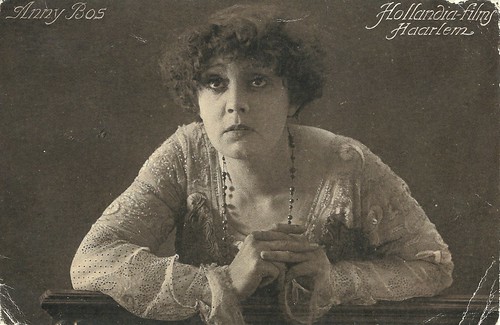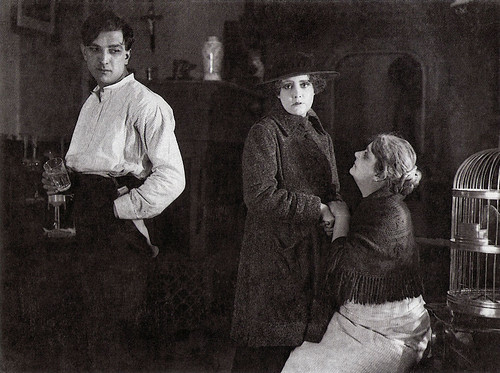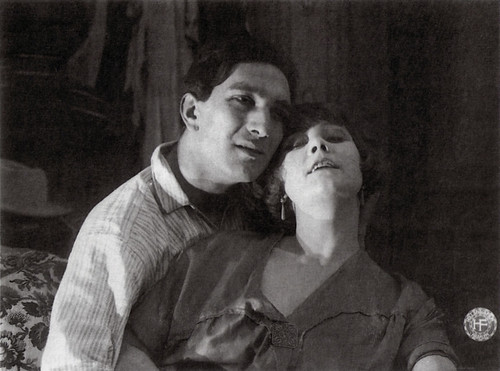
A rare Dutch postcard for Annie Bos, written here as Anny Bos. Photo: Hollandia-films, Haarlem. For us, this postcard was a holy grail. We're proud and glad to have found it.

Dutch postcard by E & B. Photo: Annie Bos in Toffe jongens onder de mobilisatie (deel 1)/Cool boys under the mobilisation (part 1) (Jan van Dommelen, 1914). Translation caption: The coast guard, My Johnny is here all day on the coast watching, I think he likes a bath, so I'll be the coast guard.

Italian promotion postcard for Philips. Photo: Emrik & Binger, Haarlem. Captions: Philips, Eindhoven (Olanda). Ragazza Olandese 11. Lampada Philips, Risparmio 75%, Luce Bianchissima.
Hollandia
Annie Bos was born in Amsterdam in 1886 as Johanna Bos, daughter of painter Gerard Jan Bos and his wife Aletta Maria Gertruda Halberstadt. Her father enabled her to follow the drama school in Antwerp, where she made her theatre debut. However, she soon returned to the Netherlands where she first appeared on stage in 1909. For three years she played small roles at the Van Lier brothers company and later joined that of Prot, but she had just a few opportunities to flourish as a stage actress here.
In November 1912 director Maurits Binger offered her the lead role in the film De levende ladder/The Living Ladder (Maurits Binger 1913). Binger had founded the production company Filmfabriek (film factory) Hollandia in 1912 and saw Bos as the ideal muse for the female leads in his films. Bos quickly belonged to the core group of the Hollandia players, such as Willem van der Veer, Fred Vogeding, Jan van Dommelen, Coen Hissink, Paula de Waart, Christine Chrispijn-van Meeteren and actor/director Louis Chrispijn,. Over the years, she received more and more recognition.
Her popularity grew also internationally, as Binger distributed her films over the borders as well, right from the start of De levende ladder. The audience preferred Bos over other Dutch actresses because of her natural style of play. The press compared her to the Franco-Russian actress Stacia Napierkowska. After the thrilling film Liefde waakt/An Artist’s Model (Louis Chrispijn, 1914) was released, Bos was nicknamed "the Dutch Asta Nielsen", turning her into the first Dutch film diva. Bos herself, though, hated that nickname and rather preferred the Italian diva Francesca Bertini. Across the country, young female fans imitated her hairstyle.
She was seen mainly in society dramas, thrill films and film adaptations of plays and books. Her big breakthrough came in 1916 when she played the lead in Majoor Frans/Major Frans (Maurits Binger, 1916), with Bos in a man-like role, as her character was raised as a boy because of an allowance by an aunt. The young Frans as a child was played by Lily Bouwmeester, who would become a Dutch film star in the 1930s. Although Bos received praise from critics, she was convinced that the transfer of her interpretation of the main character in Majoor Frans had failed.
From then on Bos became the most wanted film actress, but she nevertheless continued to do her own stunts. For a famous scene from Het geheim van Delft/The Secret of Delft (Maurits Binger, 1917), she let herself strapped to a mill’s wing going up to forty meters, and doing several rounds (filmed by the cameraman who did the same). As a reward, director and producer Binger gave her a bottle of champagne.

Adelqui Migliar and Annie Bos. Publicity still. Source: Immagine. Nuova Serie N. 16, 1990-1991.

Adelqui Migliar and Annie Bos. Publicity still for Een Carmen van het Noorden/Carmen of the North (Maurits H. Binger, Hans Nesna, 1919). Source: Immagine. Nuova Serie N. 16, 1990-1991.
Anna Bosilova
In her next film, Madame Pinkette & Co. (Maurits Binger, 1917), Annie Bos first played opposite the Chilean actor Adelqui Migliar. They would be paired in a long string of films, including De kroon der schande/The Coronet of Shame (Maurits Binger, 1918), the three-part film Oorlog en vrede 1914/1916/1918/War and Peace 1914/1916/1918 (Maurits Binger, 1918) and Toen’t licht verdween/When the Light Vanished (Maurits Binger, 1918).
Over the years, Bos got more chances to prove herself as an actress, as she started demanding more versatility in her characters. She played a demure young lady in the fishermen’s drama Op hoop van zegen/The Good Hope (Maurits Binger 1918), a comedian in American Girls (Maurits Binger, Louis Davids, 1919), and a daring femme fatale in Een Carmen van het Noorden/A Carmen of the North (Maurits Binger, Hans Nesna, 1919). In 1920 she was awarded a medal for her acting career.
After the end of World War I, filmmaking became more expensive. In 1919 Hollandia was about to go bankrupt and teamed up with a British studio to avoid collapse. Hollandia became Anglo-Hollandia. Bos still had the female lead in Het verborgen leven/The Hidden Life (Maurits Binger, B.E. Doxat-Pratt, 1920) and Zonnetje/Joy (Maurits Binger, B.E. Doxatt-Pratt, 1920), while Binger gave her the lead in a last project of his own: Rechten der Jeugd/Youth’s Rights (Maurits Binger, 1921).
Bos had to accept that female leads at Anglo-Hollandia went more and more to British actresses such as Mary Odette, e.g. in De vrouw van den minister/John Herriott’s Wife (Maurits Binger, B.E. Doxatt-Pratt, 1920). She was internationally named Anna Bosilova.
When Anglo-Hollandia reorganised at the end of 1920, the studio bosses decided Bos had to leave because they thought her too old. Meanwhile, Bos appeared in the US to be a popular actress because of A Carmen of the North, so an American version was planned and Bos was offered a contract which guaranteed her to star in the remake. She moved to New York in April 1921 but once arrived, she discovered the studio didn’t exist anymore. Bos did several auditions with other film studios but to no avail. She only had a small role alongside American actress Pearl White in the Fox production Without Fear (Kenneth S. Webb, 1922) and was named in the credits as Anna Boas.

Dutch postcard by E & B. Photo by HAP Film / Bens Film, Den Haag. Jan van Dommelen in the film Schakels (Maurits Binger, 1920), based on a play by Herman Heijermans.

Mary Odette. British postcard in the Pictures Portrait Gallery, no. 49, by Pictures Ltd., London. Photo: Claude Harris.
When the light disappeared
Unable to get any more film parts in the US, Annie Bos returned to Europe for health reasons in November 1922. Film lights had damaged her eyes. After a successful eye operation in Berlin, she tried to find her luck in Germany but this failed as well. In 1924 she eventually returned to the Netherlands.
There, Hollandia had gone bankrupt in 1922 and only two shaky Dutch film studios remained. Alex Benno, a director whom she knew from her days at Hollandia, insisted she would do the title role in Mooi Juultje van Volendam/Beautiful July of Volendam (Alex Benno, 1924), a folklorist film.
Although her comeback was accompanied by media attention, the film flopped and was removed from cinemas after just one week. In November 1924 Bos returned to the stage and was featured in the hit play 'Madame Dubarry'. However, in 1925 she decided to quit acting for good. In 1926, she married notary Cornelis Loeff and became a housewife, soon forgotten by the public.
Her death at Leiden, on 3 August 1975, was mentioned in only one newspaper, Het Vrije Volk. Shortly before her death, she told her life story to Dutch film historian Geoffrey Donaldson, who made an extensive article, published in 1978 in the film magazine Skrien. In 1997 Donaldson dedicated his book Of Joy and Sorrow: A Filmography of Dutch Silent Fiction to her. In 2006, film actress Willeke van Ammelrooy brought Bos under the footlight in a stage monologue called Toen ‘t licht verdween (When the Light Disappeared), entitled after one of Bos’s films.
Several films with Annie Bos have shown up either in Dutch or foreign archives, such as De levende ladder, Twee Zeeuwse meisjes in Zandvoort/Two Zealand Girls in Zandvoort (Louis Chrispijn, 1913), De wraak van het vissersmeisje/The Fishergirl’s Vengeance (Jan van Dommelen 1913), Majoor Frans, Het geheim van Delft/The Secret of Delft, Zonnetje/Joy, John Herriot’s Wife, and, most recently, in 2011, De Bertha/The “Bertha’ (Louis Chrispijn, 1914). From her other titles only fragments remain, while most of her films are still lost.
Trailer for the film program dedicated to Annie Bos. The program ran in the Filmmuseum in the winter of 2006. Source: Filmmuseum Amsterdam (YouTube).
Twee Zeeuwse meisjes in Zandvoort/Two Zealand Girls in Zandvoort (Louis Chrispijn, 1913). Source: Eye (YouTube).
Sources: Geoffrey Donaldson (Of Joy and Sorrow: A Filmography of Dutch Silent Fiction, 1997), Wikipedia (English and Dutch) and IMDb.
No comments:
Post a Comment